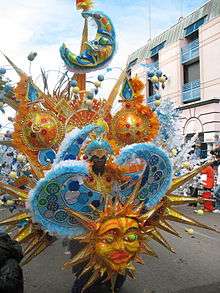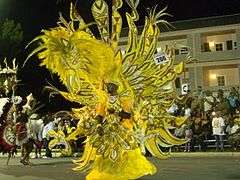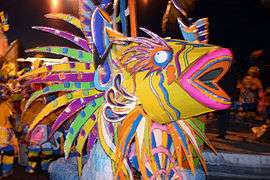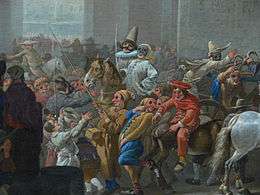Junkanoo
Junkanoo (or Jonkonnu) is a street parade with music, dance, and costumes of mixed African origin in many islands across the English speaking Caribbean every Boxing Day (26 December) and New Year's Day (1 January), the same as "Kakamotobi" or the Fancy Dress Festival of Ghana. These cultural parades are predominantly showcased in the Bahamas where the music is also mainstreamed. There are also Junkanoo parades in Miami in June and Key West in October, where local black populations have their roots in the Caribbean. In addition to being a culture dance for the Garifuna people,[1][2] this type of dancing is also performed in The Bahamas on Independence day and other historical holidays.
| Junkanoo | |
|---|---|
 Junkanoo (or "John Canoe") celebrants (Kingston, Jamaica, Christmas 1975) | |
| Status | Active |
| Genre | Folk festival, street festival, parade |
| Country | Caribbean |
| Music of the Anglophone Caribbean | |
|---|---|
| Genres | |
| Regional music | |
| Local forms | |
| Related areas | |
Dances are choreographed to the beat of goatskin drums and cowbells.
History
The festival may have originated several centuries ago, when enslaved descendants of Africans on plantations in The Bahamas celebrated holidays granted around Christmas time with dance, music, and costumes. After emancipation the tradition continued and junkanoo evolved from simple origins to a formal, organised parade with intricate costumes, themed music and official prizes within various categories.
The origin of the word junkanoo is disputed. Theories include that it is named after a folk hero named John Canoe or that it is derived from the French gens inconnus (unknown people) as masks are worn by the revelers.[3] Douglas Chambers, professor of African studies at the University of Southern Mississippi, suggests a possible Igbo origin from the Igbo yam deity Njoku Ji referencing festivities in time for the new yam festival. Chambers also suggests a link with the Igbo okonko masking tradition of southern Igboland which feature horned maskers and other masked characters in similar style to jonkonnu masks.[4] Similarities with the Yoruba Egungun festivals have also been identified.[5] However, an Akan origin is more likely because the celebration of the Fancy Dress Festivals/Masquerades are the same Christmas week(Dec 25- Jan 1st) and also John Canoe was in fact an existing king and hero that ruled Axim, Ghana before 1720, the same year the John Canoe festival was created in the Caribbean.[6]
According to Edward Long, an 18th-century Jamaican slave owner/historian, the John Canoe festival was created in Jamaica and the Caribbean by enslaved Akans who backed the man known as John Canoe. John Canoe, from Axim, Ghana, was an Akan from the Ahanta. He was a soldier for the Germans, until one day he turned his back on them for his Ahanta people and sided with Nzima and Ashanti troops, in order to take the area from the Germans and other Europeans. The news of his victory reached Jamaica and he has been celebrated ever since that Christmas of 1708 when he first defeated Prussic forces for Axim. Twenty years later his stronghold was broken by neighbouring Fante forces aided by the military might of the British and Ahanta, Nzima and Ashanti captives were taken to Jamaica as prisoners of war. The festival itself included motifs from battles typical of Akan fashion. The Ashanti swordsman became the "horned headed man"; the Ashanti commander became "Pitchy patchy" who also wears a battledress with what would resemble charms, referred to as a "Batakari".[7]
Description
Many of the colonies Jonkonnu was prominent, Bahamas, Jamaica (as Jankunu), Virginia celebrated Jonkonnu.[4]
Historian Stephen Nissenbaum described the festival as it was performed in 19th-century North Carolina:
Essentially, it involved a band of black men—generally young—who dressed themselves in ornate and often bizarre costumes. Each band was led by a man who was variously dressed in animal horns, elaborate rags, female disguise, whiteface (and wearing a gentleman's wig!), or simply his "Sunday-go-to-meeting-suit." Accompanied by music, the band marched along the roads from plantation to plantation, town to town, accosting whites along the way and sometimes even entering their houses. In the process the men performed elaborate and (to white observers) grotesque dances that were probably of African origin. And in return for this performance they always demanded money (the leader generally carried "a small bowl or tin cup" for this purpose), though whiskey was an acceptable substitute.[8]

Popular culture
The Junkanoo parade has featured in movies including the James Bond film Thunderball (erroneously described as a local Mardi Gras-type festival), After the Sunset and Jaws The Revenge, as well as in the season one episode "Calderone's Return (Part II)" of the 1984 television series Miami Vice, taking place on the fictitious island of St. Andrews.
In the television show Top Chef: Allstars Season 8, episode 13, "Fit for a King", the contestants danced at the Junkanoo parade, learned about its history and competed to make the best dish for the Junkanoo King.
Gallery
 Rush for Peace (Freeport, Bahamas, 2011)
Rush for Peace (Freeport, Bahamas, 2011)- Costume sans participant after the parade
 Junkanoo costume
Junkanoo costume Junkanoo costume
Junkanoo costume Junkanoo Festival, Nassau 2005
Junkanoo Festival, Nassau 2005 Junkanoo musician 2005
Junkanoo musician 2005
See also
- Carnival
- Pitchy patchy
- John Canoe, the 1708 king of Axim, after whom the practice may have been named
References
- Ericka Hamburg (December 23, 2007), Free to dance - Belize's liberating Jonkonnu celebration recalls a slavery-era tradition, Los Angeles Times, p. 3, retrieved October 15, 2013
- Gene Scaramuzzo (April 28, 1989), African-Caribbean Music Takes Off, The Times-Picayune, p. L21
- "What is Junkanoo". Official Website of the Bahamas Tourist Office. The Bahamas Tourist Office UK. Retrieved 22 December 2015.
- Chambers, Douglas B. (March 1, 2005). Murder at Montpelier: Igbo Africans in Virginia. University Press of Mississippi. p. 182. ISBN 1-57806-706-5.
- Allsop, Richard (2003). The Dictionary of Caribbean English Usage. Jamaica: University of the West Indies Press. p. 776. ISBN 978-976-640-145-0.
- "Fort Gross Frederiksburg, Princestown (1683)", Ghana Museums and Monuments Board.
- Long, Edward (1774). "The History of Jamaica Or, A General Survey of the Antient and Modern State of that Island: With Reflexions on Its Situation, Settlements, Inhabitants, Climate, Products, Commerce, Laws, and Government" (google). 2 (3/4): 445–475. Cite journal requires
|journal=(help) - Stephen Nissenbaum, The Battle for Christmas. New York: Vintage Books, 1997, p. 285.
Sources
- Bethel, Clement. Junkanoo: Festival of the Bahamas. Macmillan Caribbean, 1992.
- Nissenbaum, Stephen. The Battle for Christmas. New York: Vintage Books, 1997.
- Wisdom, Keith Gordon. Bahamian Junkanoo: An Act in a Modern Social Drama (Dissertation)
- Wood, Vivian Nina Michelle. Rushin' hard and runnin' hot: Experiencing the music of the Junkanoo Parade in Nassau, Bahamas (Dissertation)
External links
| Wikimedia Commons has media related to Junkanoo. |
- https://web.archive.org/web/20160105052613/http://www.saxonsjunkanoo.org/
- http://www.ancestraltravels.com
- http://www.bahamaslife.com
- http://www.coloursbahamas.com
- https://web.archive.org/web/20080320111103/http://junkanoopaparazzi.com/
- http://www.shidor.com
- https://www.fest300.com/festivals/junkanoo-parade
- http://www.bahamas.com/whatisjunkanoo
